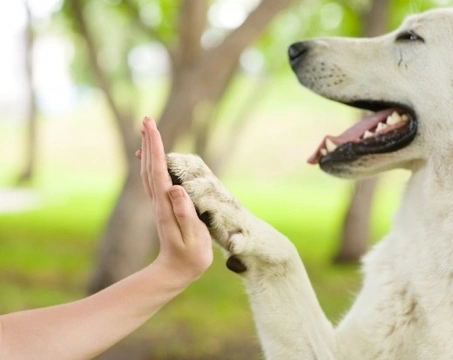Pets
Pets for studWanted petsBreedersAccessories & services
Knowledge hub
Support
Support & safety portal
The language of paws - How dogs use their paws to communicate
As social and pack animals, dogs have a wide range of different methods of communication at their disposal, some of which can prove mysterious to us people who speak a different language entirely! As well as body language, barking, growling and the wagging tail, one of the most common means of canine communication, and one that is often overlooked, is the language that dogs speak with the movements of their paws. Don’t be confused into thinking that this is something akin to a mimed sign language, or some method of tapping out a Morse code-like language to other dogs; it is not that complicated! However, the way that dogs communicate using their paws and physical leg movements can be very telling, and something that dog owners can easily learn about.
Read on to learn all about how dogs communicate using their paws.
I want to play!
If your dog is trying to incite you into playing with them, they will usually make their intentions perfectly clear! They will probably be close to you, wagging their tail, bounding around and possibly barking, and they will also use their body language and their front paws in an open posture to try to invite you to interact with them.
It your dog is “bowing” to you, with their butt in the air and their chest down, with their legs splayed out and their front paws open towards you, they are inviting you into their space and letting you know that they would like a game.
That’s mine!
If you have a treat or toy in your hand and your dog wants it, they will sometimes give you the universal sign for “show me that” or “give that to me,” by pawing at your hand or the object in question. Batting at something or pawing at it is one of the ways that dogs try to take ownership of something or let you know that they would like to have it, just as keeping a paw on a toy or resource lets other dogs know that it is theirs.
Asking for attention
Using a paw to tap or rub against your leg or body is a clear indication that your dog is trying to get your attention, and is the canine equivalent of a friend tapping you on the shoulder to let you know that they are there! While it is fairly instinctive that if your dog paws at you you will speak to them or give them attention, be careful not to teach your dog that this is the best way to speak to you, as mucky paws on your leg can soon ruin your outfit!
Asking to be let out
If a closed door is standing between your dog and where they want to be, they will often paw and scrape at the door in an attempt to coax it open. They may be physically trying to push the door open by doing this, but more likely, they are aware that if they paw at the door, you will get up and open it for them!
Indicating submission
Paws can also indicate submission from your dog, particularly when accompanied by other submissive body language. Dogs that yield dominance to another dog or person will often lie on their backs, exposing their vulnerable neck and belly, in an indication to the other dog or person that they know that that party is boss, and that they are not a threat. The paws in this case will be up in the air, loose and freely moving, and you will be able to move your dog’s legs around by moving their paws.
Indicating dominance
Dogs can also use their paws to let another dog or person know that they think they are boss, and in a wide variety of ways. If your dog is playing with another dog and they use their front paw or paws to physically push the other dog away, keep them at a distance or push them down, your dog is trying to assert dominance over the other dog. Sometimes dogs will sit with their paw on the back or neck of another dog, and this is a clear indication that the dog with the paw raised is dominant, or the boss.
Dogs can also use their paws and the positioning of their paws to show that they feel that they are dominant over a certain person, although this can be harder to identify. It is particularly common to see family dogs with young children showing gentle dominance or guardianship in this way, such as by sitting with a proprietary paw on the child, or by pushing the child down with their paws.
Similarly, if your dog jumps up and puts their paws on your shoulders, this is their way of letting you know that they see themselves as either your boss, or your equal. In some cases, these subtle signs of dominance in the dog can expand into other areas of their behaviour and cause a problem, so be alert to these subtle signs of dominance, and know how to handle them.



